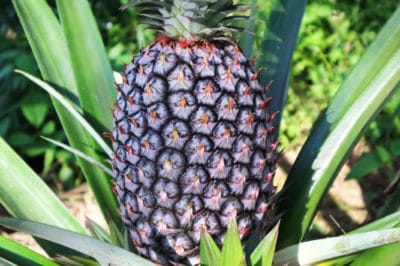Planting And Propagation
Starting plants from the green tops of fruit is the simplest way to plant pineapples. Instead of composting your pineapple tops, plant them. Each green top is a cutting from which a new plant can grow.
Pull the top off of the pineapple by twisting it. Remove the lower layers of leaves from around the bottom. You can let it cure in the air for a day or two to allow those wounds to harden before planting it.
Gently set this top into the soil. Put it in a pot filled with high-quality well-draining potting soil or in the tropics place it directly into an outdoor gardening bed that has well-draining soil.
There is no need to bury it deep or pack soil around it. It thrives when in light contact with the earth like its cousin the air-plant.
Watering And Feeding
Plants will need full sunlight or six hours of direct light per day. If the plants are indoors, supplemental lighting may be necessary.
Watering pineapple plants is simple. As long as they are mulched to avoid evaporation, they need very little water. To find out if you should water, look at the pockets where the leaves come together in the crown. If there is water in those pockets, then you probably don’t need to water.
If they are dry, go ahead and pour some water over the top of the plant. Allow it to fill the pockets and soak into the soil. Underwatering can result in smaller fruits, so be sure to check regularly.
When feeding your plant, make sure the nutrients get onto the leaves. Pineapples take in a lot of nutrients through their leaves. What you choose for fertilizer is up to you. Mixing compost into the original soil is a slow release feed. Other organic nutrients include:
- Fish emulsion
- Compost tea
- Epsom salts
- Diluted urine
- Diluted manure
When mixing your liquid feeds, heavily dilute them. Pineapple plants are susceptible to damage from over feeding. You do want the nutrients to get onto the leaves, but avoid letting it pool in the central crown pockets.
Harvest
Pineapples can take between 12 and 18 months to reach a ripe stage. Ripe fruits will have flattened fruitlets, be yellow in color, and smell of fresh ripe pineapple.
